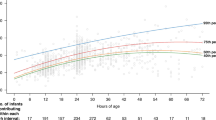Abstract
Background
To determine the incidence and risk factors of post-phototherapy rebound hyperbilirubinemia because data about bilirubin rebound in neonates are lacking and few studies have concerned this condition.
Methods
A prospective observational study was conducted on 500 neonates with indirect hyperbilirubinemia who were treated according to standard guidelines. Total serum bilirubin (TSB) was measured at 24–36 h after phototherapy; significant bilirubin rebound (SBR) is considered as increasing TSB that needs reinstitution of phototherapy.
Results
A total of 124 (24.9%) neonates developed SBR with TSB increased by 3.4 (2.4–11.2) mg/dL after stopping phototherapy. Multiple logistic regression model revealed the following significant risk factors for rebound: low birth weight (B = 1.3, P < 0.001, OR 3.5), suspected sepsis (B = 2.5, P < 0.001, OR 12.6), exposure to intensive phototherapy (B = 0.83, P = 0.03, OR 2.3), hemolysis (B = 1.2, P < 0.001, OR 3.1), high discharge bilirubin level (B = 0.3, P = 0.001, OR 1.3), and short duration of conventional phototherapy (B = − 1.2, P < 0.001, OR 0.3).
Conclusions
SBR should be considered in neonates with hemolysis, low birth weight, suspected sepsis, short duration of conventional phototherapy, exposure to intensive phototherapy, and relatively high discharge TSB. These risk factors should be taken into account when planning post-phototherapy follow-up.

Similar content being viewed by others
References
Yetman RJ, Parks DK, Huseby V, Mistry K, Garcia J. Rebound bilirubin levels in infants receiving phototherapy. J Pediatr. 1998;133:705–7.
Al-Saedi SA. Rebound hyperbilirubinemia in term infants after phototherapy. Saudi Med J. 2002;23:1394–7.
Erdeve O, Tiras U, Dallar Y. Rebound bilirubin measurement is not required for hyperbilirubinemia regardless of the background attributes of the newborns. J Trop Pediatr. 2004;50:309.
Brown AK, Kim MH, Wu PY, Bryla DA. Efficacy of phototherapy in prevention and management of neonatal hyperbilirubinemia. Pediatrics. 1985;75:393–400.
Maisels MJ, Kring E. Rebound in serum bilirubin level following intensive phototherapy. Arch Pediatr Adolesc Med. 2002;156:669–72.
Kaplan M, Kaplan E, Hammerman C, Algur N, Bromiker R, Schimmel MS, et al. Post phototherapy neonatal bilirubin rebound: a potential cause of significant hyperbilirubinaemia. Arch Dis Child. 2006;91:31–4.
American Academy of Pediatrics Subcommittee on Hyperbilirubinemia. Management of hyperbilirubinemia in the newborn infant 35 or more weeks of gestation. Pediatrics. 2004;114:297–316.
Bansal A, Jain S, Parmar VR, Chawla D. Bilirubin rebound after intensive phototherapy for neonatal jaundice. Indian Pediatr. 2010;47:607–9.
Ip S, Chung M, Kulig J, O’Brien R, Sege R, Glicken S, et al. An evidence-based review of important issues concerning neonatal hyperbilirubinemia. Pediatrics. 2004;114:130–53.
Johnson L, Brown AK, Bhutani VK. BIND—a clinical score for bilirubin induced neurologic dysfunction in newborns. Pediatrics. 1999;104:746–7.
Maisels MJ, Bhutani VK, Bogen D, Newman TB, Stark AR, Watchko JF. Hyperbilirubinemia in the newborn infant ≥ 35 weeks’ gestation: an update with clarifications. Pediatrics. 2009;124:1193–8.
Maisels MJ, Watchko JF, Bhutani VK. StevensonDK. An approach to the management of hyperbilirubinemia in the preterm infant less than 35 weeks of gestation. J Perinatol. 2012;32:660–4.
Lazar L, Litwin A, Merlob P. Phototherapy for neonatal nonhemolytic hyperbilirubinemia. Clin Pediatr. 1993;92:651–7.
Del Vecchio MT, Benstock MA, Sundel ER. Bilirubin rebound. J Pediatr. 1999;135:531–2.
Berkwitt A, Osborn R, Grossman M. The utility of inpatient rebound bilirubin levels in infants readmitted after birth hospitalization for hyperbilirubinemia. Hosp Pediatr. 2015;5:74–8.
Jodeiry B, Fakhraee SH, Kazemian M, Afjeiee SA, Javaherizadeh H. Rebound hyperbilirubinaemia in neonates admitted to Mofid Children’s Hospital, Tehran, Iran. SAJCH. 2013;7:22–4.
Ambalavanan N, Carlo WA. Jaundice and hyperbilirubinemia in the newborn. In: Kliegman RM, Behrman RE, Jenson HB, Stanton BF, editors. Nelson textbook of pediatrics, 19th edn, vol 96(3). Philadelphia: Saunders Elsevier; 2012. p. 1943–62.
Romano EL, Hughes-Jones NC, Mollison PL. Direct antiglobulin reaction in ABO-haemolytic disease of the newborn. Br Med J. 1973;1:524–6.
Murray NA, Roberts IA. Haemolytic disease of the newborn. Arch Dis Child Fetal Neonatal Ed. 2007;92:F83–8.
Hansen TW. The role of phototherapy in the crash-cart approach to extreme neonatal jaundice. SeminPerinatol. 2011;35:171–4.
Chang PW, Kuzniewicz MW, McCulloch CE, Newman TB. A clinical prediction rule for rebound hyperbilirubinemia following inpatient phototherapy. Pediatrics. 2017;139:e20162896.
Niknafs N, Nili F, Dalili H, Nayeri F, Esmaeilnia T, Amini E. A Comparison of significant bilirubin rebound after discontinuation of phototherapy in two groups of neonates in Valiasr Hospital: a randomized clinical trial. IJN. 2014;4:17–21.
Valinjkar SK, Sutay NR, Sharma B. Rebound hyperbilirubinemia in neonates after phototherapy and factors affecting it. JMSCR. 2017;5:19003–14.
Madan A, MacMahon JR, Stevenson DK. Neonatal hyperbilirubinemia. In: Taeusch HW, Ballard RA, Gleason CA, editors. Avery’s diseases of the newborn, vol. 79. 8th ed. Saunders: Philadelphia; 2005. p. 1226–55.
Funding
No funding.
Author information
Authors and Affiliations
Contributions
EIM designed the study, shared in analysis and interpretation of data, and made a critical revision of the article and final approval of the version to be published. AGEA shared data collection and interpretation of data, drafted the article and final approval for publishing; AWA shared in data acquisition and critical revision for important intellectual contents and final approval for publishing; ISHG shared in data acquisition and analysis and critical revision for important intellectual content.
Corresponding author
Ethics declarations
Ethical approval
The study was approved by the Ethics Committee of Pediatric Department, Faculty of Medicine, Cairo University.
Conflict of interest
There are no conflicts of interest among all authors.
Rights and permissions
About this article
Cite this article
Elhawary, I.M., Abdel Ghany, E.A.G., Aboelhamed, W.A. et al. Incidence and risk factors of post-phototherapy neonatal rebound hyperbilirubinemia. World J Pediatr 14, 350–356 (2018). https://doi.org/10.1007/s12519-018-0119-9
Received:
Accepted:
Published:
Issue Date:
DOI: https://doi.org/10.1007/s12519-018-0119-9




